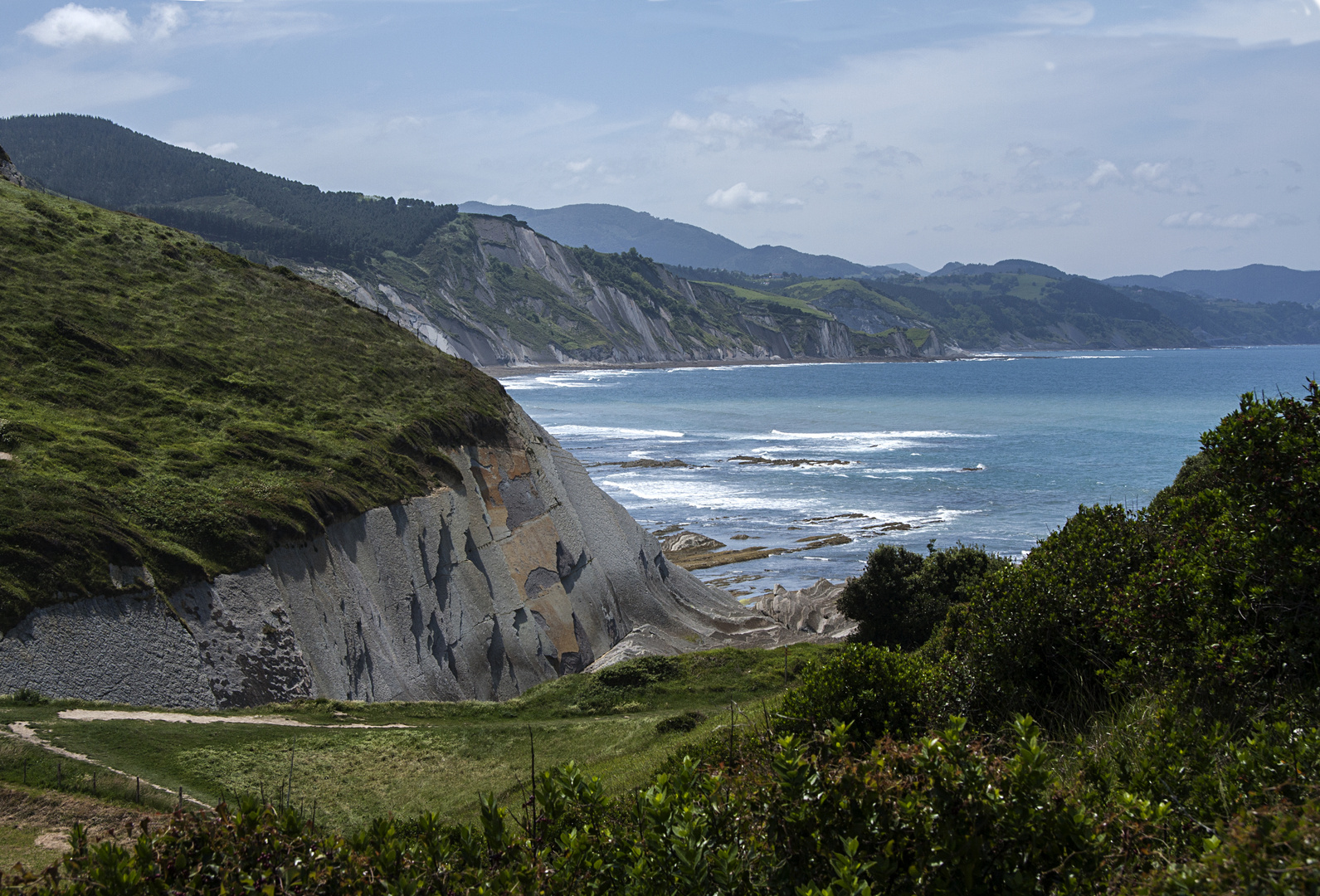Flisch
Zumaia, Gipuzkoa
Los flysch son facies rocosas de origen sedimentario compuestas por alternancia rítmica de capas de rocas duras —cohesivas— (calizas, pizarras o areniscas) intercaladas con otras más blandas —friables— (margas o lutitas). Esta disposición favorece la erosión diferencial, pues las capas friables son desgastadas con mayor facilidad que las capas cohesivas. Esto hace que las capas duras se queden en resalte y sin apoyo, que así son erosionadas más fácilmente, pero a la vez la existencia de las rocas duras protege a las blandas.
El término proviene del alemán y es relativamente antiguo, creado antes del estudio en detalle del fenómeno que describe. Quiere decir 'fluir', 'deslizarse' o 'terreno que resbala'.
Formación
Este tipo de sedimentación alternante ha sido objeto de numerosas investigaciones que causaron bastante polémica. Ha habido dos hipótesis de trabajo sobre su formación: hasta los años 50 del siglo XX se defendía la hipótesis de las playas fósiles, pero después se impuso la hipótesis de las corrientes de turbidez en las zonas profundas del océano.
Playas fósiles. Esta hipótesis defiende que la formación de los flysch se ha realizado a partir de la sedimentación costera, en un fenómeno parecido a la formación de las playas. Se basaba en el aspecto de la superficie de las capas areniscas en las que aparecen rizaduras, señales que recuerdan a las figuras dejadas por el oleaje en las arenas de las playas. De esta observación se pasó a la conjetura de que debían de ser sedimentos playeros litificados.
Mediante turbiditas. La hipótesis más aceptada es la de la formación de sedimentos en la zonas profundas de los océanos. Estos sedimentos serían los procedentes de las corrientes oceánicas de gran turbidez que discurren por la pendiente del fondo dejando sedimentos llamados turbiditas. Las rizaduras observadas se interpretan ahora como de corriente, no de oleaje.
Atendiendo a la hipótesis de las turbiditas se puede estimar que el flysch se forma de la siguiente forma:
una corriente con carga de sedimentos se desliza por un talud sobre el fondo abisal del océano excavando una estructura sobre la superficie original del océano o la que ha dejado un episodio anterior de este mismo tipo;
al disminuir la velocidad comienza la sedimentación del material que arrastra la corriente en diferentes capas ordenadas por las densidades de los mismos. Estas sedimentaciones son de forma laminar;
cuando la corriente se calma se sedimentan los materiales más ligeros dando forma a las partes arcillosas del conjunto.
**********************************************************
Flysch (/fl??/) is a sequence of sedimentary rock layers that progress from deep-water and turbidity flow deposits to shallow-water shales and sandstones. It is deposited when a deep basin forms rapidly on the continental side of a mountain building episode. Examples are found near the North American Cordillera, the Alps, the Pyrenees and the Carpathians.
Sedimentological properties
Flysch consists of repeated sedimentary cycles with upwards fining of the sediments. There are sometimes coarse conglomerates or breccias at the bottom of each cycle, which gradually evolve upwards into sandstone and shale/mudstone. Flysch typically consists of a sequence of shales rhythmically interbedded with thin, hard, graywacke-like sandstones. Typically the shales do not contain many fossils, while the coarser sandstones often have fractions of micas and glauconite.
Tectonics
In a continental collision, a subducting tectonic plate pushes on the plate above it, making the rock fold, often to the point where thrust faults form, and a mountain chain rises. On the upper plate, the land between the mountains and the undeformed continent bends downward, forming a foreland basin. If the basin forms slowly, as in the northern Appalachians, it fills with shallow-water sediments.[1] If it forms rapidly, as in the east side of the North American Cordillera, then sea water may rush in, and the first sedimentary deposits are deep water deposits. If the mountain slope is steep enough at the edge of the basin, it will shed material in rapidly moving sedimentary flows called turbidity currents, resulting in turbidite deposits. As the basin fills up, shallow-water sandstones and continental deposits form.[1][2] Most of the resulting rocks have little deformation, but near the edge of the mountain chain they can be subject to folding and thrusting.[1] After the basin fills up, continental sediments (molasse) are deposited on top of the flysch.[2]
Name and use
Carpathian Flysch
The name flysch was introduced in geologic literature by the Swiss geologist Bernhard Studer in 1827. Studer used the term for the typical alternations of sandstone and shale in the foreland of the Alps. The name comes from the German word fliessen, which means to flow, because Studer thought flysch was deposited by rivers. The insight that flysch is actually a deep marine sediment typical for a particular plate tectonic setting came only much later.[3]
The name flysch is currently used in many mountain chains belonging to the Alpine belt. Well-known flysch deposits are found in the forelands of the Pyrenees and Carpathians and in tectonically similar regions in Italy, the Balkans and on Cyprus. In the northern Alps, the Flysch is also a lithostratigraphic unit.




















sparkling light 20/06/2019 19:58
What a view. Marvellous.Jost
Claudio Micheli 18/06/2019 22:28
Davvero molto bella!Ciao
Hans-Olaf FLÜGEL 18/06/2019 16:33
A very interesting landscape. It looks very good and gives new insperation for holidays.Regards from olly